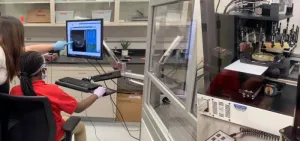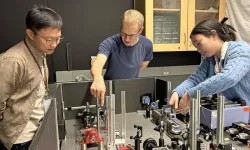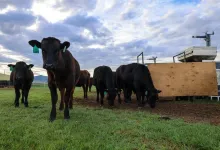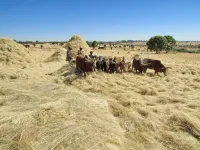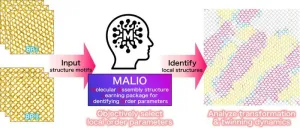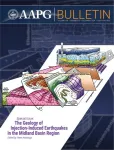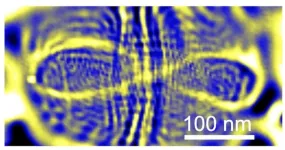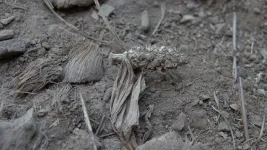(Press-News.org) Researchers at the University of Arizona College of Medicine – Tucson received $1.7 million in funding from the Centers for Disease Control and Prevention to improve knowledge regarding the prevalence, mortality and health outcomes for people of all ages living with spina bifida.
Spina bifida is a birth defect that occurs when an embryo’s spinal cord does not properly close during the third and fourth weeks of pregnancy, resulting in a gap in the spine. According to the CDC, spina bifida occurs in 1 of every 2,875 births in the United States each year. Spina bifida can affect multiple body systems with symptoms ranging from mild to severe. It can cause mobility issues, urinary system complications and cognitive difficulties.
Advancements in medical care and folate supplementation have led to a reduced prevalence of spina bifida, but little is known about the unmet needs and gaps in care experienced by people with the condition as they age.
“Conducting population-based surveillance of children with spina bifida into adulthood is critical for understanding what factors contribute to the health and quality of life of individuals living with spina bifida,” said principal investigator Jennifer Andrews, PhD, an associate professor of pediatrics at the College of Medicine – Tucson and director of the Arizona Research Investigating Disability and Disorders, or ARID Lab, at the Steele Children’s Research Center. “Surveillance systems for birth defects identify babies born with a birth defect but do not have the capacity to follow them as they become children and adults.”
This project supplements the efforts of the CDC-sponsored National Spina Bifida Patient Registry by including longitudinal data for individuals with spina bifida who are not being treated by specialty care clinics. The funding will allow researchers to work with project sites to collect clinical data on spina bifida patients of all ages to increase knowledge of the spina bifida population, regardless of where individuals receive care.
Once collected, the data could be used to inform clinicians, public health programs, the spina bifida community and the public about the health status and outcomes for people with spina bifida.
“We want to ensure everyone has access to resources needed for optimal health and a high quality of life,” Andrews said. “To do this, we need better data on what gaps and unmet needs exist for people with spina bifida across all ages.”
This project is funded by the Department of Health and Human Services’ Centers for Disease Control and Prevention under award no. NU01DD000045.
END
$1.7 million CDC grant will allow researchers to study spina bifida across the lifespan
University of Arizona College of Medicine – Tucson researchers hope to gain a better understanding of what factors contribute to the health and quality of life of people living with the birth defect
2024-12-02
ELSE PRESS RELEASES FROM THIS DATE:
Study: Even low levels of arsenic in drinking water raise kidney cancer risk
2024-12-02
New research findings from the Texas A&M University School of Public Health indicate that exposure to even low levels of arsenic poses significant health risks, including an increased risk of kidney cancer.
The incidence of kidney cancer in the United States rose by an average of 1.2 percent each year between 2011 and 2019 to become the seventh most common cancer. In the meantime, smoking — a well-established risk factor for kidney cancer — has continued to decline.
This led researchers to consider other possible contributing factors, including arsenic, a known cause of various cancers that is naturally occurring ...
How a middle schooler found a new compound in a piece of goose poop
2024-12-02
A group of young students became bonafide biomedical scientists before they even started high school. Through a partnership with a nearby university, the middle schoolers collected and analyzed environmental samples to find new antibiotic candidates. One unique sample, goose poop collected at a local park, had a bacterium that showed antibiotic activity and contained a novel compound that slowed the growth of human melanoma and ovarian cancer cells in lab tests.
Inequities in educational resources, especially those in science, engineering, technology and math (STEM), where ...
UBCO researchers engineer DNA to mimic biological catch bonds
2024-12-02
In a first-of-its-kind breakthrough, a team of UBC Okanagan researchers has developed an artificial adhesion system that closely mimics natural biological interactions.
Dr. Isaac Li and his team in the Irving K. Barber Faculty of Science study biophysics at the single-molecule and single-cell levels. Their research focuses on understanding how cells physically interact with each other and their environment, with the ultimate goal of developing innovative tools for disease diagnosis and therapy.
Two of Dr. Li’s doctoral students, Micah Yang and David Bakker, have engineered a new molecule that could transform how cells adhere to and communicate with one another.
Micah Yang, ...
Feeding grazing cattle seaweed cuts methane emissions by almost 40%
2024-12-02
Seaweed is once again showing promise for making cattle farming more sustainable. A new study by researchers at the University of California, Davis, found that feeding grazing beef cattle a seaweed supplement in pellet form reduced their methane emissions by almost 40% without affecting their health or weight. The study was published today (Dec. 2) in Proceedings of the National Academy of Sciences.
This is the first study to test seaweed on grazing beef cattle in the world. It follows previous studies that showed seaweed cut methane emissions 82% in feedlot cattle ...
Animal products improve child nutrition in Africa
2024-12-02
The consumption of milk products, eggs and fish has a positive effect on childhood development in Africa. This has been demonstrated in a recent study by the CABI's regional centre for Africa in Nairobi, Kenya and the University of Bonn. The researchers used representative data from five African countries with over 32,000 child observations. If the children had a diet containing animal products, they suffered less from malnutrition and related developmental deficiencies. The study has now been published in the journal PNAS.
Almost 150 million children under the age of five around the world suffer from serious growth and developmental ...
Dynamics of structural transformation for liquid crystalline blue phases
2024-12-02
Fukuoka and Tsukuba, Japan—Researchers have uncovered key insights about how liquid crystals, materials capable of forming complex ordered structures, transform between different phases. Published in PNAS, the study provides a clearer understanding of how these materials change their structures at the microscopic level. This research could provide a means to give a deeper insight into the transformation between different structures in a wider variety of materials.
Liquid crystals are materials that exhibit properties of both liquids and solids. They flow like liquids but can also ...
Study untangles how COVID-19 wreaks widespread damage in the body
2024-12-02
New research published in the journal Proceedings of the National Academy of Sciences sheds light on the pathways that drive organ damage and death in severe COVID-19 and helps explain why survivors of the disease can experience long-term complications.
“Our study resolves some of the long-standing unanswered questions about how the SARS-CoV-2 virus impacts the body,” said co-senior author Afshin Beheshti, Ph.D., professor of surgery and computational and systems biology at the University of Pittsburgh School of Medicine and associate director of the McGowan Institute for Regenerative Medicine. “The findings point ...
New research provides an improved understanding of earthquake hazards in the Permian Basin
2024-12-02
A new collection of published papers offers the most detailed and comprehensive breakdown yet of how water injected into the Permian Basin during oil and gas operations is changing subsurface pressures and causing earthquakes.
The Permian Basin in West Texas is the country’s most prolific energy-producing region, accounting for more than 40% of the nation’s oil production and about 15% of gas production. However, energy production has caused earthquakes and other challenges in recent years as oil and gas operators now manage roughly 15 million barrels of produced wastewater each day. This briny water comes to the surface ...
Physics experiment proves patterns in chaos in peculiar quantum realm
2024-12-02
Where do you see patterns in chaos? It has been proven, in the incredibly tiny quantum realm, by an international team co-led by UC Santa Cruz physicist Jairo Velasco, Jr. In a new paper published on November 27 in Nature, the researchers detail an experiment that confirms a theory first put forth 40 years ago stating that electrons confined in quantum space would move along common paths rather than producing a chaotic jumble of trajectories.
Electrons exhibit both particle and wave-like properties—they ...
Partially domesticated maize is found in caves in Minas Gerais state, Brazil
2024-12-02
Brazilian scientists have determined that ancient specimens of partially domesticated maize (Zea mays, also known as corn) originally from Peruaçu Valley in Minas Gerais state (Brazil) were the farthest from Mexico, the plant’s historic center of origin, of any finds made so far. An article describing their research is published in the journal Science Advances. The study was led by researchers affiliated with the University of São Paulo (USP) and EMBRAPA, the Brazilian Agricultural Research Corporation.
The findings reinforce the theory, based on genetic evidence from plants alive now, that domestication ...
LAST 30 PRESS RELEASES:
University of Oklahoma researcher awarded funding to pursue AI-powered material design
Exploring how the visual system recovers following injury
Support for parents with infants at pediatric check-ups leads to better reading and math skills in elementary school
Kids’ behavioral health is a growing share of family health costs
Day & night: Cancer disrupts the brain’s natural rhythm
COVID-19 vaccination significantly reduces risk to pregnant women and baby
The role of vaccination in maternal and perinatal outcomes associated with COVID-19 in pregnancy
Mayo Clinic smartwatch system helps parents shorten and defuse children's severe tantrums early
Behavioral health spending spikes to 40% of all children’s health expenditures, nearly doubling in a decade
Digital cognitive behavioral treatment for generalized anxiety disorder
Expenditures for pediatric behavioral health care over time and estimated family financial burden
Air conditioning in nursing homes and mortality during extreme heat
The Alps to lose a record number of glaciers in the next decade
What makes a good proton conductor?
New science reporting guide published for journalists in Bulgaria
New international study reveals major survival gaps among children with cancer
New science reporting guide published for journalists in Turkey
Scientists develop a smarter mRNA therapy that knows which cells to target
Neuroanatomy-informed brain–machine hybrid intelligence for robust acoustic target detection
Eight SwRI hydrogen projects funded by ENERGYWERX
The Lundquist Institute and its start-up company Vitalex Biosciences Announces Strategic Advancement of Second-Generation fungal Vaccine VXV-01 through Phase 1 Trials under $40 Million Competitive Con
Fine particles in pollution are associated with early signs of autoimmune disease
Review article | Towards a Global Ground-Based Earth Observatory (GGBEO): Leveraging existing systems and networks
Penn and UMich create world’s smallest programmable, autonomous robots
Cleveland researchers launch first major study to address ‘hidden performance killer’ in athletes
To connect across politics, try saying what you oppose
Modulating key interaction prevents virus from entering cells
Project explores barriers to NHS career progression facing international medical graduates
Jeonbuk National University researchers explore the impact of different seasonings on the flavor perception of Doenjang soup
Two Keck Medicine of USC Hospitals named Leapfrog Top Teaching Hospitals
[Press-News.org] $1.7 million CDC grant will allow researchers to study spina bifida across the lifespanUniversity of Arizona College of Medicine – Tucson researchers hope to gain a better understanding of what factors contribute to the health and quality of life of people living with the birth defect

